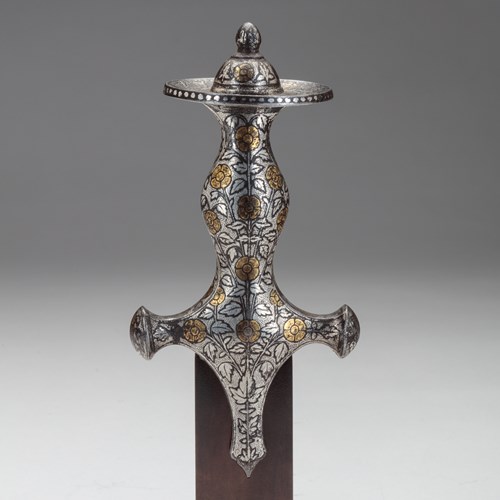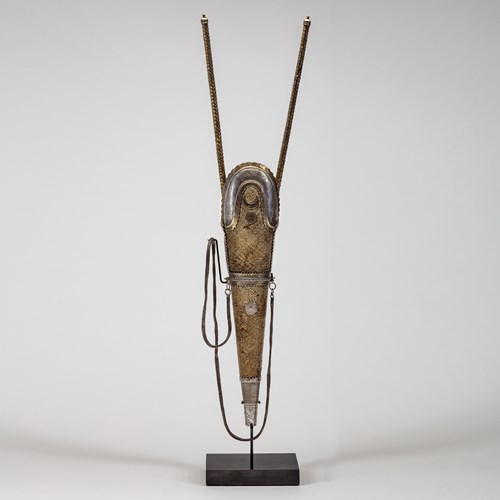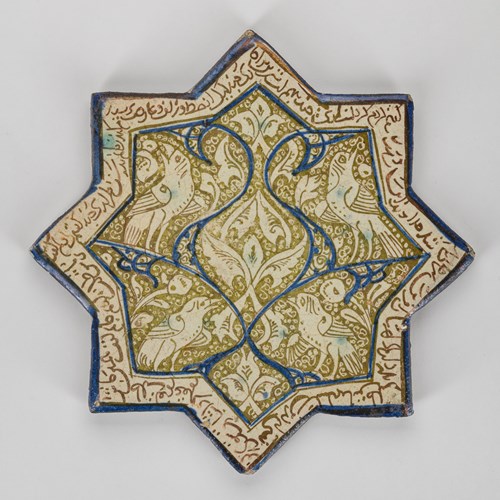Marketplace
Rare Ganga-Jamuna Suit of Mail Armour
Comprising a helmet (kulāh-khūd), mail shirt (zereh), and mail chausses (pyjama zereh), this well-preserved suit of armour would probably have been worn by a high-ranking member of the Sikh Empire, whose capital was at Lahore. The suit is distinctive for its ‘Ganga-Jamuna’ patterned mail, so called because its contrasting colours resembled the confluence of the sacred rivers of the Ganges and the Jamuna. The patterns – chevrons on the chausses and diamonds on the shirt and camail – are created using dark grey steel rings, golden-coloured brass rings, and reddish copper rings. The rings are butted together, meaning their ends are unwelded and do not overlap. Two Ganga-Jamuna mail shirts originating from early 19th century India are held in the collection of the Metropolitan Museum of Art in New York (accession nos 36.25.57 and 36.25.22 b,c) and a further from the late 18th century in the Victoria and Albert Museum in London (accession no. 3183 (IS)). Furthermore, two comparable full suits of armour from late 18th century Lahore can be found in the collection of the Royal Armouries in Leeds (accession nos XXVIA.6 and XXVIA.8).
The helmet, based on the Persian kulāh-khūd (کلاه خود), is formed from a watered steel hemispherical bowl decorated with gold koftgari. Riveted at the front of the bowl is a bracket that secures a sliding nose protector (damāghak), which can be secured in a raised position with a hook and eye latch. Either side of the nose protector are two small porte aigrettes or plume holders (jā parī) with flattened lobed bases. A characteristic third jā parī is positioned at the top of the helmet, decorated with chevron pattern, replacing the spike typically found on Persian helmets. These would have been used to mount feathers (ablaq) from birds such as the heron, egret, or peacock.1 The feathers taken from the helmets of vanquished enemies were sometimes displayed as a trophy.2 An example of a helmet from Lahore complete with feathers can be seen in the collection of the V&A (accession no. 118A-1852). A long mail aventail for neck protection, created from unwelded rings of just 3mm diameter, attaches through holes around the rim of the bowl. The mail’s lower edge is vandyked, terminating in two long triangular points and two shorter ones. A helmet of similar form is held in the Royal Armouries in Leeds (accession no. XXVIA.36 A).
The helmet is decorated with radiating ridged lines damascened in gold. Between each ridge is a cluster of cinquefoil flowers. A border of gold overlay with a vine etched into it runs along the rim of the helmet. The base of the top plume holder has the form of an upturned flower. The influence of the arts of the Mughals, the former rulers of Lahore, can be seen in the floral ornamentation of the helmet.
n.b. all accession nos are clickable links
1 Gahir, Sunita, and Spencer, Sharon (eds). Weapon – A Visual History of Arms and Armor. New York City: DK Publishing, 2006. P. 268.
2 Moshtagh Khorasani, Manouchehr. Arms and Armour from Iran: The Bronze Age to the End of the Qajar Period. Tübingen: Legat, 2006. P. 284.
The helmet, based on the Persian kulāh-khūd (کلاه خود), is formed from a watered steel hemispherical bowl decorated with gold koftgari. Riveted at the front of the bowl is a bracket that secures a sliding nose protector (damāghak), which can be secured in a raised position with a hook and eye latch. Either side of the nose protector are two small porte aigrettes or plume holders (jā parī) with flattened lobed bases. A characteristic third jā parī is positioned at the top of the helmet, decorated with chevron pattern, replacing the spike typically found on Persian helmets. These would have been used to mount feathers (ablaq) from birds such as the heron, egret, or peacock.1 The feathers taken from the helmets of vanquished enemies were sometimes displayed as a trophy.2 An example of a helmet from Lahore complete with feathers can be seen in the collection of the V&A (accession no. 118A-1852). A long mail aventail for neck protection, created from unwelded rings of just 3mm diameter, attaches through holes around the rim of the bowl. The mail’s lower edge is vandyked, terminating in two long triangular points and two shorter ones. A helmet of similar form is held in the Royal Armouries in Leeds (accession no. XXVIA.36 A).
The helmet is decorated with radiating ridged lines damascened in gold. Between each ridge is a cluster of cinquefoil flowers. A border of gold overlay with a vine etched into it runs along the rim of the helmet. The base of the top plume holder has the form of an upturned flower. The influence of the arts of the Mughals, the former rulers of Lahore, can be seen in the floral ornamentation of the helmet.
n.b. all accession nos are clickable links
1 Gahir, Sunita, and Spencer, Sharon (eds). Weapon – A Visual History of Arms and Armor. New York City: DK Publishing, 2006. P. 268.
2 Moshtagh Khorasani, Manouchehr. Arms and Armour from Iran: The Bronze Age to the End of the Qajar Period. Tübingen: Legat, 2006. P. 284.
More artworks from the Gallery







_T638772015617641557.jpg?width=500&height=500&mode=pad&scale=both&qlt=90&format=jpg)

 Untitled 1_T638206163537998306.jpg?width=500&height=500&mode=pad&scale=both&qlt=90&format=jpg)